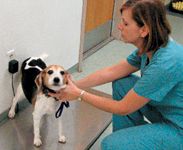Bond clients for life
These case studies show how to strengthen your relationships with clients and grow your practice.
You have a vision for a new program for your practice, and it's going to be great. It's going to strengthen the bond between clients and pets, maximize patients' well-being, and help your practice and your team grow. The only hitch: You need your doctors and team members to think it's a great idea, too.

Laura Cornett, RVT, shows the weight-based age chart her team uses to educate clients during wellness exams.
Of course, it's up to your doctors to determine whether these programs fit your practice's mission. The teams who launched these programs agree that the doctors must get on board first, and the team needs to plan and train thoroughly before introducing a program to clients.
To jump start the planning process and help build buy-in, set aside time during a team training session or staff meeting to discuss your ideas and uncover any obstacles. Those who've helped launch new programs will tell you team members must accept the new idea if you want it to be successful. They must support the program and those who lead it by participating with their own pets and delivering a consistent message about the program's importance to clients.
These practices invested the time and money to teach all of their team members how to educate clients and make consistent recommendations. Consider their advice to launch a successful program in your practice.
Blast off with a behavior program
Preventing canine behavior problems before they begin is the goal of the behavior training program at Nassau Veterinary Clinic in Nassau, N.Y. Sixteen years ago, the practice was losing its share of patients to shelters because of behavioral problems. So practice manager Florence Sanford, CVPM, hired Marlene Wagner, a veterinary assistant and Certified Pet Dog Trainer (CPDT), to start a positive, reward-based training course to bond clients and pets from puppyhood and preserve their relationship with the practice. Wagner and her team of trainers, which includes two clients with experience in agility and rally obedience training and classes, plan and teach the courses one night a week.
An alternative to traditional obedience training, the initial course, "Basic Life Skills, or More Manners Please," taught pets to be good household citizens in a fun, gentle, and instructive way. Today, the single class has expanded into a series, which kicks off with free monthly puppy parties, followed by puppy kindergarten, adolescent finishing school, a beginners' agility or rally obedience course, and an American Kennel Club Canine Good Citizen course. Each five- to eight-week course, which costs $95 to $125, uses the skills developed in the preceding training courses.

Figure 1
Nassau Veterinary Clinic also offers a secondhand dogs course for adopted dogs and their owners. And the practice's responsible pet owners program entitles clients who have completed at least one training course to a discount on their pet's ovariohysterectomy or neuter. In June, the team launched a new program called "Tails on Trails" that provides clients and their pets the opportunity to practice what they've learned in two or more previous training courses in a public setting, such as a shopping center or park.
Do it yourself
The National Council on Pet Population Study and Policy reports behavior problems are the top reason Americans relinquish their dogs to shelters. In 2007, 36 percent of puppies that visited Nassau Veterinary Clinic for puppy visits enrolled in puppy kindergarten, and 149 dogs took behavior courses at the practice. To launch an effective behavior program, consider these steps:
- Establish a vision. Determine what your team wants to accomplish so you know how to train pets. For example, if a goal is to strengthen the relationship and build trust between clients and pets, Wagner recommends employing positive, reward-based training methods with treats, toys, and play.
- Identify trainers who fit your practice's vision. Veterinary assistants who excel at teaching clients in the exam room are obvious candidates, but don't overlook other team members with a passion for training. "I'll bet in every hospital there's somebody who spends a lot of time training their own pets and who's dedicated to training," Sanford says.
When looking for trainers outside the practice, Sanford suggests hiring a CPDT. Wagner holds this national certification for experienced dog trainers, which is grounded in humane training practices. All CPDTs have at least 300 hours of dog training experience, have passed a standardized exam covering five areas of dog training, follow a code of ethics, and are required to complete continuing education.
- Invest in training and continuing education. Practice managers: Your role is to give trainers education, goals, and incentives to help build the program. Wagner and the other trainers at Nassau Veterinary Clinic attend the Association of Pet Dog Trainers annual conference and at least two local seminars a year.

Marlene Wagner and Florence Sanford, CVPM, with Lieka, a Greater Swiss mountain dog Wagner trained for therapy work.
Sanford encourages every member of the behavior training team to participate in local seminars by paying the cost of the registration, and trainers will also share highlights from educational events with the rest of the practice team.
- Start without dogs. New instructors might consider holding an educational seminar just for clients before bringing dogs into the picture. This approach worked for Wagner, who limited the first class of the practice's original life skills course to pet owners only.
- Encourage the whole team to participate. Every team member at Nassau Veterinary Clinic talks up puppy parties to pet owners during puppy visits, which is easy since many of them have attended the parties and participated in training courses with their own dogs. To encourage participation, the courses are free to team members.
Many doctors' and team members' shifts end while class is in session, and they follow a practice rule to stop in to give treats, cuddle a puppy, or say hello to clients on their way out, Wagner says.
- Use your practice management software to help market the program. The practice team codes first puppy visits in the software system and includes a puppy party invitation and a behavior program brochure in the practice's puppy packs. Wagner later uses the software to generate a list of new puppy patients seen since the last puppy party and follows up with a personalized message addressed to the puppy.
The benefits
By preempting behavioral problems, the team at Nassau Veterinary Clinic has helped keep most of its patients in homes and out of the shelter. Canine students are excited to visit the practice for school, and the pooches rarely behave poorly because they've learned in class to relax during handling.

Marlene Wagner leads a terrier puppy over a mini-agility obstacle during a puppy kindergarten class.
Another plus: The team is able to increase touch time with patients and clients and expand on exam room education topics, such as vaccinations and potty training tips, during puppy parties and puppy kindergarten. The program also offers a career growth opportunity for team members to expand their skill set and their pay. Inexperienced team members who are interested in teaching classes might consider apprenticing with veteran trainers or volunteering with shelters and rescue groups.
Strengthen bonds with end-of-life care
Though they haven't always used the term hospice, Robin Downing, DVM, Dipl. AAPM, and Firstline Editorial Advisory Board member Sharon DeNayer have provided hospice care for years. Since Dr. Downing opened Windsor Veterinary Clinic in Windsor, Colo., in 1991, the end-of-life care team has grown to two doctors, three certified veterinary technicians (CVTs) and DeNayer, the practice manager, who serves as the practice's bereavement companion.
The team has also shifted from primarily examining and treating hospice patients in their homes to teaching clients to treat their pets at home. Averaging one to five patients in the program at any time, the team communicates with clients over the phone and sees patients at the practice as needed, for a total of one to two hours a week per patient. Some patients require house calls and may need as much as six hours of dedicated individual care a week. The goal: to help terminally ill patients live as comfortably as possible for the rest of their lives while educating and supporting their owners.

Robin Downing, DVM, and Sharon DeNayer cuddle with Kramer, a 13-year-old hospice patient that suffers from a terminal kidney condition.
When a doctor at Windsor Veterinary Clinic determines a patient is terminally ill, the doctor discusses the option of hospice care. When pet owners enter the program, DeNayer schedules a free hour-long consultation with the family to discuss what hospice care may involve for their pet, answer questions, and introduce a designated medical contact, one of the practice's CVTs. The contact serves as the family's liaison to the doctor and acts as a guide for caring for the pet during the hospice period, from administering medication and basic treatments to modifying the hospice patient's environment.
During the consultation, DeNayer also outlines the associated costs and broaches death and euthanasia to begin preparing the family for the loss of their pet. "As the family's bereavement companion, I make sure I'm available to answer questions and provide emotional and spiritual support as their beloved pet proceeds through the dying process," DeNayer says.
Team members are trained to help pet owners decide when to euthanize their pet using the seven variables of the Quality of Life scale created by Alice E. Villalobos, DVM, who owns a referral-based oncology practice with locations in Woodland Hills, Calif., and Torrance, Calif. When clients choose euthanasia, the team at Windsor Veterinary Clinic helps make euthanasia more bearable for clients, including giving clients options for the procedure and after care.
Do it yourself
"You can help your clients and patients deal with terminal illness and the dying process with dignity," DeNayer says. "These clients will bond deeply with your clinic and become your most loyal supporters." Use these steps to develop your own hospice program:
- Create euthanasia protocols. Whether your practice has a hospice care program or not, every practice handles euthanasia on a regular basis. And following protocols helps people avoid mistakes or ambiguity, which is especially important during a stressful or emotional time, DeNayer says.
- Train team members to support clients. Team members who work directly with clients must feel comfortable talking to them and offering the emotional support clients need as caregivers. Because pet owners often experience anticipatory grief when they learn their pets are terminally ill, DeNayer recommends grief training for team members to help them prepare for these difficult conversations. But she doesn't think team members need to be licensed counselors to support clients through their pet's dying process.

Figure 2
"Most of the time, clients want a good ear," DeNayer says. "They want you to listen to their concerns, and they don't necessarily want advice. They just want someone to understand what they're going through." The entire team could benefit from active listening training, she says, as well as a presentation at a team meeting by a grief counselor or hospice care worker.
- Provide support for team members. Whether it's a co-worker or someone outside the practice, team members who provide emotional support to clients need someone they can talk to about their experiences to avoid compassion fatigue. "Everyone should be aware of the symptoms of compassion fatigue and know the clinic's protocol when you see these symptoms in a team member," DeNayer says. (See "Lost Your Compassion?".)
- Decide whether you'll offer house calls. While your practice can provide hospice care for most clients at the practice, you'll need to make other arrangements for clients whose pets are difficult to transport and easily stressed by travel. You'll need to consider staff availability, scheduling, distance, and time away from the practice for house calls. The team at Windsor Veterinary Clinic schedules hospice house calls at the beginning and end of the day, when traffic is lightest at the clinic and working clients can be at home.
If house calls aren't possible, consider referring clients whose pets need in-home treatment to a local house call practitioner or a practice specializing in pain management. Or, to save doctors and technicians travel time, send a team member in a properly insured practice vehicle to pick up patients and clients.
- Determine the cost of your hospice care. Practices must evaluate the cost of running a hospice program and set fees for practice visits and house calls accordingly, she says. They also must agree on pricing with any referral practices so they can explain any fees to clients in advance.
Windsor Veterinary Clinic charges pet owners for the cost of medicine and supplies used in treating their hospice patients and the standard fee for euthanasia. The practice doesn't charge an exam fee or a house call fee, because all appointments are within 10 miles of the practice. The practice also uses a fund for pet owners unable to pay for medicine and supplies.
"Making the end of a pet's life easier for a family to experience is going to keep them bonded to your practice," DeNayer says. "So it's an area where we've chosen to sacrifice some income to make it as easy on them as possible."
The benefits
The end of life is a safe, caring, and intimate experience for hospice patients, DeNayer says. Through the practice's hospice program, pet owners receive moral support and time to adjust to the situation, and they're able to say goodbye on their own terms.
Unlike some programs, hospice care doesn't require any special equipment and, depending on how you price it, the program can boost the practice's profits. Additionally, a hospice program enhances team members' communication skills, engages them in an emerging field in veterinary medicine, reassures them they've prevented suffering and made an ill pet more comfortable, and hones their teaching skills, DeNayer says.
Weigh in with a pet weight loss program
At Seaside Animal Care in Calabash, N.C., team members do their part to combat obesity. "This isn't only the client's fight, it's our fight, too," says Gina Toman, a Firstline board member and a veterinary assistant.
Toman, who serves as the team training coordinator at Seaside Animal Care, ensures every team member can assign a correct body condition score and knows the diets the doctor recommends and the practice sells. So, while doctors assign body condition scores in the exam room, receptionists and kennel assistants can gauge pets' body condition to recommend an appropriate food choice for walk-in customers and boarded pets.
During annual exams, team members weigh the pet and discuss the pet's current diet, including treats and the pet's daily caloric needs based on its estimated ideal weight. After examining the pet and assigning a body condition score, the doctor recommends blood work for any pet that's overweight or obese, then sets a realistic weight loss goal for the pet's first weight check.
On the exam form, the doctor writes the weight goal for the pet in pounds, food recommendations, and when the pet should visit for a weight check. Team members then offer the client a copy of the exam form and a handout on weight reduction and review the recommendations. Then the receptionist makes sure clients take home any recommended food and schedules a weight check appointment for clients or uses the system's practice management software to generate a reminder.

Gina Toman and Ernest E. Ward Jr., DVM, bring human fitness experience to the practice's weight loss program. Toman previously worked as a personal trainer and Ward is a triathlete.
Do it yourself
A weight loss program improves pets' health and quality of life, lowering their risk of developing serious medical conditions. Consider these steps to launch an effective program:
- Record the pet's weight. If your team isn't ready to launch a full-scale weight loss program, Toman recommends adding the current weight and previous weight to your exam form first. "It gives you a communication opener for discussing weight and health," she says.
Next, encourage clients with overweight and obese pets to visit for weigh-ins, perhaps 30, 60, and 90 days after the initial visit. Allow pet owners to make an appointment for a weight check before they leave the practice, or let them stop in for the free weight check at their convenience. If a pet isn't losing weight, team members and pet owners can reevaluate the plan, including the type of food and treats recommended.
- Encourage success. To help pets lose weight safely and to avoid overwhelming clients, the Seaside Animal Care team breaks the weight pets need to lose into small achievable goals, usually 3 percent to 5 percent of dogs' body weight and 1 percent to 2 percent of cats' body weight a month. The team calculates how many calories the pet should be fed a day based on its target weight and converts that into cups per feeding for the client.
To drive home just how much pet owners feed their pets, team members offer a handout that lists the calorie contents for major store-bought pet foods and treats. Clients also receive a free bag of the recommended therapeutic diet to help make the transition easier and a free measuring cup to accurately measure food servings.
- Be sensitive when discussing pets' weight. Team members at Seaside Animal Care don't judge how pets have become overweight or obese. Instead, they appeal to how much clients care for their pets while discussing the increased health risks associated with excess body weight, such as heart disease, osteoarthritis, cancer, and diabetes mellitus, according to the Association for Pet Obesity Prevention. Toman might say, "We know you love Scooter so much and that you want to do the best thing for him. You wouldn't want to have to administer insulin injections every day. If we can reduce his weight, we can help prevent diabetes and other life-threatening diseases." And she shares the struggles she's had with weight in her own pets and is honest about the challenges and rewards of weight loss. This shows clients she understands where they're coming from and conveys they're working as a team in this effort.
- Involve the whole team. When clients and their pets meet their goals, team members brag about their accomplishments to other team members and doctors in front of the client. Clients love the recognition.
The benefits
A healthy lifestyle may extend pets' lives—and team members' relationships with pets and clients. Pre-weight-loss blood testing contributes to the practice's bottom line, and Toman believes the resulting longevity of pets' lives is profitable as well. Clients are happier because their pets are happier, and they take pride in their pets' weight loss.

Gina Toman weighs a beagle that is in the weight loss program and close to reaching her weight goal. The Association for Pet Obesity Prevention defines obesity as a 15 percent increase over optimum body weight.
For team members, the program holds its own rewards. "We don't often have the opportunity to intervene and halt a disease process," Toman says. "But with obesity, we can reduce pets' risk of developing certain diseases and change the outcome and quality of pets' lives just by monitoring what patients eat, discussing diet realistically with clients, and following up with them."
Promote wellness with blood testing program
Based on the belief that wellness blood testing is better medicine for the pet and better medicine is better business, Robert Stannard, DVM, owner of Adobe Pet Hospital in Livermore, Calif., introduced annual junior wellness blood testing and biannual senior wellness blood and urine testing four years ago. Since then, Dr. Stannard and his team have developed a program to encourage client compliance during biannual wellness visits—a potent assortment of communication strategies the team uses starting with puppy and kitten visits.
The team informs clients they'll run the first lab panel before their pet's ovariohysterectomy or neuter to verify the pet is healthy to undergo surgery and establish a baseline for junior wellness testing. When team members present junior wellness testing during wellness visits, they emphasize that the panel is the only way to accurately determine whether the pet is healthy.

Robert Stannard, DVM, says his team's enthusiasm and commitment drive the program. And identifying patients' diseases early reaffirms their beliefs.
Do it yourself
Eighty-eight percent of Adobe Pet Hospital's clients opt for wellness panels. "And that's just testimony that clients are ready to invest in making sure their beloved four-legged family members are healthy and well," he says. Here are the steps he suggests for a successful program:
- Use simple terms. In the exam room, team members review a laminated handout with pet owners that educates them about how the junior or senior wellness panel benefits patients in easy-to-understand terms. Rather than using medical test names, like BUN and creatinine, the handout reads, "measures the health of the kidneys."
- Tell, show, and relate. Dr. Stannard recognizes that if he reinforces what he tells clients in the exam room with visual tools and can help clients understand the need for wellness blood testing, he can boost the amount of information clients retain from 20 percent up to 80 percent, and with that, the odds of achieving compliance.
When Dr. Stannard enters the exam room, he immediately starts referring to the pet in human years rather than calendar years, using a weight-based age chart to pinpoint the animal's biological age. This reminds clients that pets age more quickly than people and puts their pet's age in perspective.
If a client hasn't yet chosen the recommended blood test for her pet, Dr. Stannard relates wellness blood testing to human blood work and asks how medically revealing the client's own physical exam would be without lab testing. As the pet owner considers her own experience, he adds, "It's even more important we test Precious because Precious can't tell us how she feels."
- Share stories. In the exam room and in the practice's quarterly newsletter, the team tells stories of pets whose lives have been saved, including the story of Greta, a long-haired dachshund with a parathyroid gland disorder that would have been missed without regular senior blood testing. "If we hadn't detected the disorder, Greta most likely would have died or experienced permanent kidney damage," Dr. Stannard says.
"Cases like this impress both our team members and clients and demonstrate how important and valuable wellness testing is. And they're perfect to include in mailers to pet owners and on our Web site," he says.
- Combine blood work with other tests to create value. Because the practice requires annual heartworm testing for pets, the practice packages the junior and senior blood panels with testing for heartworm infection, Lyme disease, ehrlichiosis, and anaplasmosis for dogs and testing for heartworm infection, feline immunodeficiency virus, and feline leukemia for cats.
The educational handouts the team uses in exams show pet owners the savings they receive by choosing the panel over individual tests. Because the labor is the same for one test as it is for the entire panel, the charge for a single test is higher than the cost of the panel. This creates value and fosters client compliance.
- Avoid prejudging a client's ability to pay. Dr. Stannard says making this mistake and refraining from offering this service can compromise the pet's health, deprive the client the opportunity to provide the best veterinary care, and deny the practice income.
The benefits
Adobe Pet Hospital's communication-based program to encourage junior and senior wellness blood testing inspires their impressive compliance rate. When pet owners arrive at the practice, most have already made the decision to participate because they received a postcard informing them their pet was due for testing and an exam. Because of the high compliance rate, the team is able to identify and treat diseases much earlier, enabling patients to live longer, healthier lives. The team takes pride in regularly finding problems before they advance to serious disease and in their ability to reassure pet owners their pet is healthy.
Wellness blood testing is also profitable. On average, 25 percent to 30 percent of Abobe Pet Hospital's gross revenue comes from lab work, and much of it is from wellness testing. Problems uncovered through wellness testing frequently lead to additional diagnostic testing. "When I get a thyroid test result that's borderline low for a dog or borderline high for a cat, I'm going to explain to the client that we need to perform a more sophisticated thyroid test," Dr. Stannard says. "The lab performs the test with the blood the team's already taken. We'll also re-test and follow elevations in other organ systems like elevated liver enzymes. So this testing generates business for the practice and work for the team."
Kristin Keeney is a freelance writer and editor in Lawrence, Kan. Please send questions or comments to firstline@advanstar.com